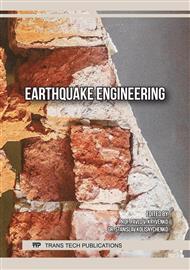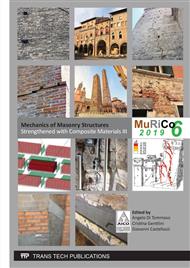[1]
Babaeidarabad S, De Caso y Basalo F, Nanni A. URM Walls Strengthened with Fabric-Reinforced Cementitious Matrix Composite Subjected to Diagonal Compression. Journal of Composites for Construction, 2013; 18(2).
DOI: 10.1061/(asce)cc.1943-5614.0000441
Google Scholar
[2]
Gattesco N, Boem I. Out-of-plane behavior of reinforced masonry walls: Experimental and numerical study. Composites Part B, 2017; 128: 39-52.
DOI: 10.1016/j.compositesb.2017.07.006
Google Scholar
[3]
Parisi F, Iovinella I, Balsamo A, Augenti N, Prota A. In-plane behaviour of tuff masonry strengthened with inorganic matrix–grid composites. Composites Part B: Engineering, 2013; 45(1): 1657-1666.
DOI: 10.1016/j.compositesb.2012.09.068
Google Scholar
[4]
Papanicolaou CG, Triantafillou TC, Karlos K, Papathanasiou M. Textile-reinforced mortar (TRM) versus FRP as strengthening material of URM walls: In-plane cyclic loading. Materials and Structures, 2007; 40(10): 1081-1097.
DOI: 10.1617/s11527-006-9207-8
Google Scholar
[5]
Donnini J, Spagnuolo S, Corinaldesi V. A comparison between the use of FRP, FRCM and HPM for concrete confinement. Composites Part B: Engineering. 2019; 160: 586-594.
DOI: 10.1016/j.compositesb.2018.12.111
Google Scholar
[6]
Corinaldesi V, Donnini J, Mazzoni G, Experimental study of adhesion between FRCM and masonry support. Key Engineering Materials, 2015; 624: 189-196.
DOI: 10.4028/www.scientific.net/kem.624.189
Google Scholar
[7]
AC434. Acceptance criteria for masonry and concrete strengthening using fiber-reinforced cementitious matrix (FRCM) composite systems. ICC-Evaluation Service, Whittier, CA; (2013).
DOI: 10.14359/51702356
Google Scholar
[8]
AC549.4R-13. Guide to design and construction of externally bonded fabric reinforcement cementitious matrix (FRCM) systems for repair and strengthening concrete and masonry structures. American Concrete Institute, Farmington Hills, MI; (2013).
DOI: 10.1016/j.prostr.2018.11.027
Google Scholar
[9]
CNR-DT215/2018. Istruzioni per la Progettazione, l'Esecuzione ed il Controllo di Interventi di Consolidamento Statico mediante l'utilizzo di Compositi Fibrorinforzati a matrice inorganica.
Google Scholar
[10]
RILEM Technical Committee 250-CSM (Gianmarco De Felice). Composites for sustainable strengthening of masonry. (2012).
Google Scholar
[11]
de Felice G, Aiello MA, Caggegi C, Ceroni F, De Santis S, Garbin E, Gattesco N, Hojdys Ł, Krajewski P, Kwiecień A, Leone M, Lignola GP, Mazzotti C, Oliveira D, Papanicolaou C, Poggi C, Triantafillou T, Valluzzi MR, Viskovic A. Recommendation of RILEM TC 250-CSM: Test method for Textile Reinforced Mortar to substrate bond characterization. Materials and Structures 2018; 51: 95.
DOI: 10.1617/s11527-018-1216-x
Google Scholar
[12]
Lignola GP, Caggegi C, Ceroni F, De Santis S, Krajewski P, Lourenço PB, Morganti M, Papanicolaou C, Pellegrino C, Prota A, Zuccarino L. Performance assessment of basalt FRCM for retrofit applications on masonry. Compos Part B-Eng 2017; 128: 1-18.
DOI: 10.1016/j.compositesb.2017.05.003
Google Scholar
[13]
Donnini J, Lancioni G, Corinaldesi V. Failure modes in FRCM systems with dry and pre-impregnated carbon yarns: Experiments and modelling, Composites Part B. 2018; 140: 57–67.
DOI: 10.1016/j.compositesb.2017.12.024
Google Scholar
[14]
Donnini J, Chiappini G, Lancioni G, Corinaldesi V. Tensile behaviour of glass FRCM systems with fabrics' overlap: Experimental results and numerical modeling. Composite Structures. 2019; 212: 398-411.
DOI: 10.1016/j.compstruct.2019.01.053
Google Scholar
[15]
Shabdin M, Zargaran M, Attari NKA. Experimental diagonal tension (shear) test of Un-Reinforced Masonry (URM) walls strengthened with textile reinforced mortar (TRM). Construction and Building Materials. 2018, 164, 704-715.
DOI: 10.1016/j.conbuildmat.2017.12.234
Google Scholar
[16]
Almeida JAPP, Pereira EB, Barros JAO. Assessment of overlay masonry strengthening system under in-plane monotonic and cyclic loading using the diagonal tensile test. Construction and Building Materials. 2015, 94, 851-865.
DOI: 10.1016/j.conbuildmat.2015.07.040
Google Scholar
[17]
Ismail N, Ingham JM. In-plane and out-of-plane testing of unreinforced masonry walls strengthened using polymer textile reinforced mortar. Engineering Structures. 2016; 118: 167-177.
DOI: 10.1016/j.engstruct.2016.03.041
Google Scholar
[18]
UNI EN 1015-11, Methods of test for mortar for masonry – Part 11: determination of flexural and compressive strength of hardened mortar, Brussels, Belgium: Comité Européen de Normalisation, (2007).
DOI: 10.3403/01905442u
Google Scholar
[19]
European Committee for Standardization. Testing concrete. Part 4: Determination of ultrasonic pulse velocity. CSN EN 12504-4: (2005).
Google Scholar
[20]
Quagliarini E, Lenci S, Iorio M. Mechanical properties of adobe walls in a Roman Republican domus at Suasa. Journal of Cultural Heritage. 2010; 11: 130-137.
DOI: 10.1016/j.culher.2009.01.006
Google Scholar
[21]
Quagliarini E, Lenci S, Piattoni Q, Bondioli F, Bernabei I, Lepore G, Zaccaria M. Experimental analysis of Romanesque masonries made by tile and brick fragments found at the archaeological site of S. Maria in Portuno, International Journal of Architectural Heritage. 2014; 8 (2): 161-184.
DOI: 10.1080/15583058.2012.683132
Google Scholar
[22]
Quagliarini E, Maracchini G. Experimental and FEM investigation on cob walls under compression. Advances in Civil Engineering, Volume 2018, Article ID 7027432, 13 pages.
DOI: 10.1155/2018/7027432
Google Scholar



